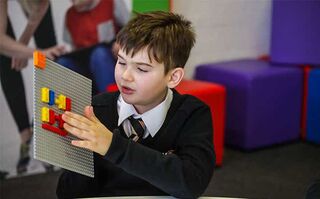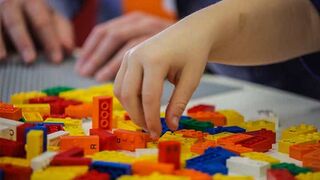Play
LEGO Braille Bricks Help Blind Children Learn to Read
The new educational toy will be available in twenty countries by the end of 2021
Posted January 17, 2021 Reviewed by Lybi Ma

LEGO is rolling out a new toy to increase literacy in blind and partially sighted children: Braille Bricks. More than just a construction game, each of these colorful blocks is molded into a letter, number, or punctuation mark of the braille writing system.
LEGOs and braille are, in many ways, a match made in heaven. A basic LEGO block is a rectangle topped with six raised dots in a 3 x 2 pattern. A braille letter is formed from an arrangement of up to six raised dots in a 3 x 2 pattern.
Braille Bricks, which spent two years in testing, were dreamed up by the blind community itself. The Danish Association of the Blind pitched the idea to the LEGO Foundation (the charitable arm of the LEGO Group) in 2011, and the Dorina Nowill Foundation for the Blind in Brazil made their own prototype in 2017.
Braille literacy has declined as technologies like audio books and screen-readers, which recite the text displayed on a computer or smartphone screen, have become more common. Advocates, though, say that auditory reading methods like these should complement braille, not replace it.
“For blind people, braille is literacy,” says Sean Randall, an IT instructor at New College Worcester, a school for the blind in the UK. Randall is himself blind. “The only other real option for someone who’s got no sight is to listen, and by listening you lose a lot of spelling, grammar, punctuation.”

Research suggests that guided play is an effective teaching tool for primary-aged students because most children learn best when they are actively engaged, interacting with others, and see meaning in what they’re doing. LEGO’s Braille Bricks can be used for play-based education in phonetics, spelling, and mathematics. For younger children who aren't yet ready to read, the blocks encourage the development of motor coordination and tactile skills.
Each brick is marked with the corresponding printed letter, number, or symbol so that blind and sighted children can enjoy them together. They’re also fully compatible with LEGO’s standard bricks, creating even more opportunities for imaginative play.
“Children dislike making mistakes,” says Sue Lock, a mathematics teacher at New College Worcester. “If you’re using a braille machine, your mistakes are there, written large. Children love being able to make something, unmake it if it’s wrong, and make it again, and that is the important thing that Braille Bricks does.”

“It’s ridiculous that all it does for us, really, is give us convenient access to moving letters around,” Randall adds. “But that opens up so many doors, and that’s a wonderful thing.”
References
Braille Bricks were released in the US, the UK, Denmark, Norway, Germany, France, and Brazil in 2020, and in 2021 they’ll be rolling out in Australia, Austria, Belgium, Canada, Finland, Ireland, Italy, New Zealand, Portugal, Spain, Sweden, Switzerland and the Netherlands. The LEGO Foundation is providing the kits free of charge to schools and organizations that serve children who are blind or partially sighted.
For more information and for games you can play with the blocks, visit the LEGO Braille Bricks website.


